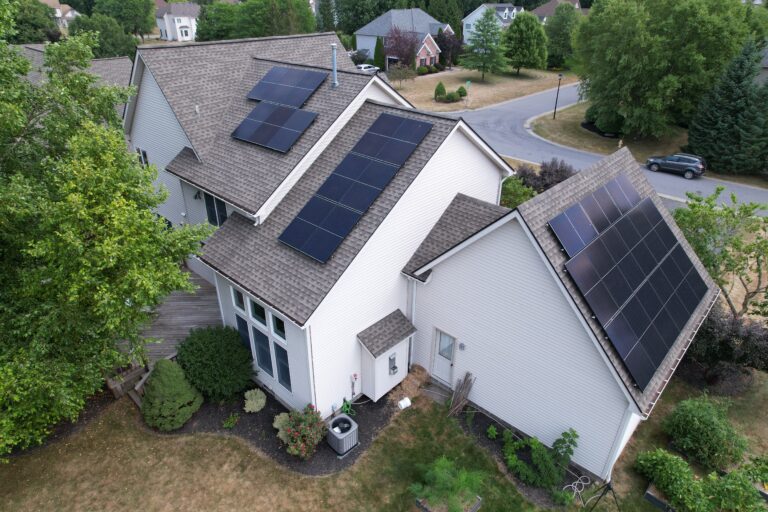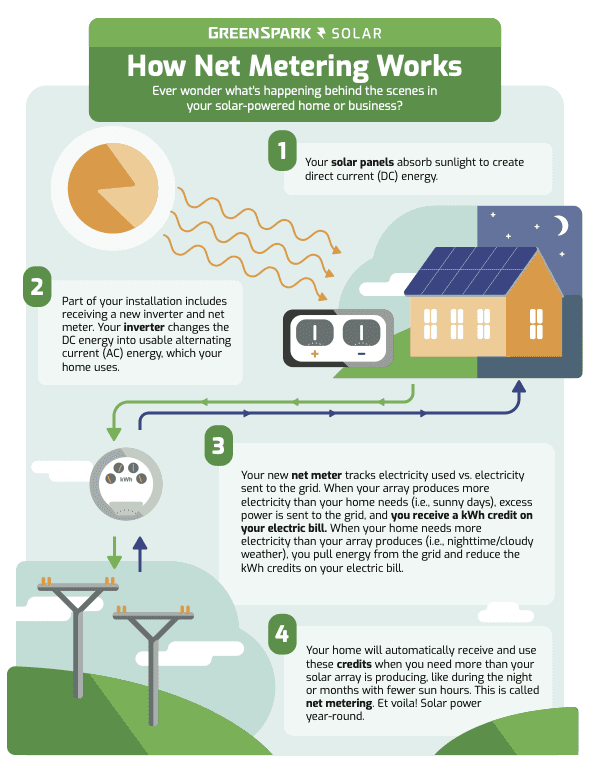Demystifying Net Metering: What New York Solar Customers Need to Know
Whether you’re new to solar or a long-time solar energy consumer, you may have come across the term “net metering” or “net energy metering.”” Many questions and misconceptions exist about what it is, how it works, and its future in monitoring solar energy. So, we’re answering all the basics about net energy metering (NEM) and digging into some big policy updates that could impact the New York State solar industry and consumers in the near future
What is Net Metering in Solar?
First, let’s start with the basics.
How do solar panels work?
Solar panels power your home or business by converting sunlight into direct current (DC) energy. An inverter then transforms this DC energy into alternating current (AC) energy that homes consume.
How are solar panel arrays sized for a home or business?
The amount of energy a home or business uses in a year usually decides how big its solar panels need to be. This makes sure that by the end of the year, the solar panels generate enough energy to cover most, if not all, of the electricity needed.
To even out months when less energy is made (like winter) with months when more is made (like summer), there’s a system called net metering. This system balances the energy used each month against what’s produced by the solar panels.

What is Net Metering in Solar?
Net metering is the way utility companies bill for solar powered electricity. It’s what makes solar panels viable in varying climate conditions (like we see in New York!). People with solar panels earn credits for any extra electricity they put into the power grid. Later on, they can use these credits to lower their future electric bills.
How does Solar Net Metering Work?
Most New York State Solar panels are grid-tied, meaning they are directly connected to the electricity grid. Being grid-tied allows for flexibility in energy use and production, which is important in an area like Rochester. During periods of low solar production, electricity is drawn from the utility grid to power the home. On the other hand, if the solar panels generate more energy than needed, the extra electricity is fed back into the grid.
The electricity meter will run backward (reverse metering) when more energy is produced than is needed to power the home. This generates a credit. These credits accrue, and when more electricity is drawn from the grid than is made, such as at night or during peak hours, these credits are applied against the extra energy used.
For simplicity’s sake, look at net metering as a one-to-one exchange. For every 1 Kw generated, you get 1 Kw back as a credit.
What are the Benefits of Net Metering?
Net metering makes solar power a viable option in New York State, as it allows solar energy customers to offset their bills during periods of lower energy production. Solar homeowners and business owners rack up credits during the summer, when solar energy production is high, for later use in the winter months.

The Impact of Net Metering Changes
A lot of “net metering buzz” is happening, and not all of it’s good news. We’re here to help unpack recent changes and help decipher what it all means for current and future solar customers in New York State.
Net Metering Changes in California
Net metering is a big topic of conversation in the solar industry due to the recent policy changes in other states, most notably California.
Utilities in other states have begun changing their policies to address grid strain, encourage solar battery purchases, and address cost-shifting. Cost-shifting occurs when utility companies claim they must charge their non-solar customers more to compensate for the revenue lost from net metering. An example of cost-shifting is the CBC (customer benefit contribution) charge for New York State solar customers put in place in 2022.
Net Metering 2.0
Looking at the history of policy changes in California, we’ve seen two major updates in the last decade. The first, Net Metering 2.0, took place in 2016. Three huge changes were made to the original policy: interconnection fees, monthly charges, and switching to time-of-use energy plans.
The NEM 2.0 shift to time-of-use energy plans was significant. This type of plan means that the utility adjusts the rate you pay for electricity over the course of the day. If energy production costs are low and demand is low (i.e., during the nighttime), the rate charged is low. If the cost of producing energy and demand is high (i.e., at dinnertime when entire families are home and using more electricity), the rate charged is high. With this plan, solar customer may pay more to “buy back” any credits they send back to the grid.
Net Metering 3.0
California changed its solar billing policy again in April 2023 to encourage the purchase of solar batteries. Unfortunately, this also reduced the value of solar-only projects. The revision to California’s policy (Net Metering 3.0, or NEM 3.0) decreased the value of solar energy credits by a whopping 75%. Now, solar customers receive a much lower credit value for any energy sent back to the grid.
In light of these changes, the solar payback period in California is likely to shift from five to six years to 14 to 15 years as a result.
Predictions for Solar in New York State
The first policy change in utility billing practices for net metered customers in New York State occurred in 2022. There were concerns that net-metered solar customers were not paying their “fair share” of energy. So, a fixed monthly dollar-per-kilowatt charge, the Customer Benefit Contribution Charge (or CBC charge), was added to residential solar customers’ bills.
Based on recent utility policy changes across the United States, the fact is that New York State solar policies are at risk. This could mean changes to the net metering structure, additional charges for solar customers (such as the CBC), or the reduction of available incentives. New Yorkers considering solar for their home are encouraged to switch now while the incentives are strong and the current billing structure is still in place.
Net Metering and Battery Storage

With potential changes in billing policy, higher utility rates that are estimated to increase an average of 22% over the next three years, and a greater likelihood of grid failures as energy consumers continue to expand their electrical demand, battery storage is becoming more and more enticing for solar customers.
When net metering ultimately goes away, as the trend is predicting, customers without on-site battery storage will be left paying more to “buy back” their banked credits when pulling electricity from the grid during peak hours.
Investing in solar plus storage now is a great way to minimize exposure to these unknowns, maximize the return on your solar investment, and minimize the payback period.
Is it time to go solar?
All this being said, what’s the verdict on whether it’s time to go solar for your home or business? The current net metering policy and active federal and state incentives make the solar payback period enticing for many homeowners. Plus, incentive options for bundling solar with battery storage make it an even wiser choice to combat rising utility costs and uncertainty over policy. The time is right for New York State residents and business owners to go solar.
Visit our battery storage page for more information, or get in touch with our team for a complete solar assessment below.






